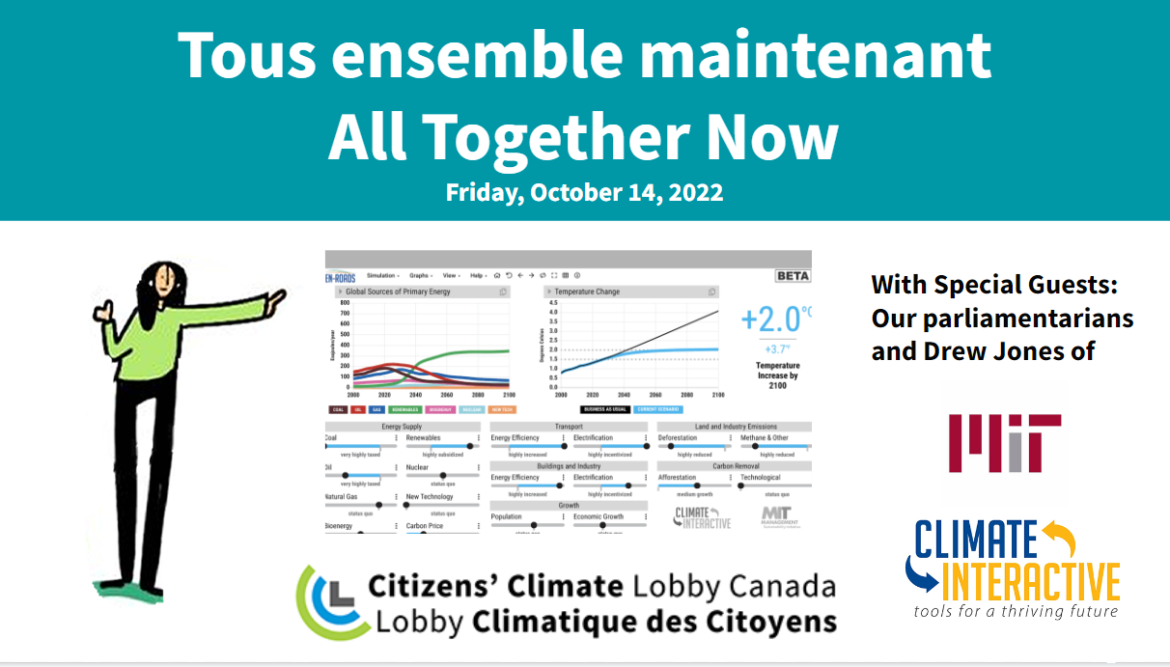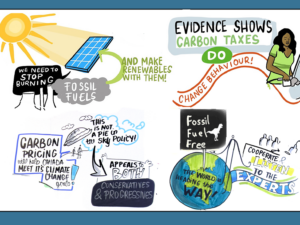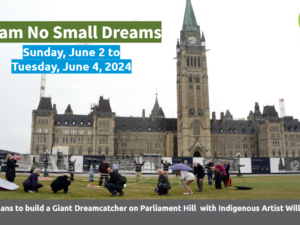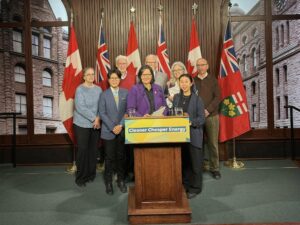DREW JONES Trained in environmental engineering and system dynamics modeling through a B.A. at Dartmouth College and a M.S. in Technology and Policy at MIT, he worked in the 1990s at Rocky Mountain Institute and in the 2000s with Dana Meadows at Sustainability Institute. He teaches system dynamics at MIT Sloan and the Kenan-Flagler Business School at the University of North Carolina at Chapel Hill.” MIT/CLIMATE INTERACTIVE’s EnROADS We invite you to join us in a first of its kind ever for us: a pan-Canadian online conference event with both of our federal and provincial parliamentarians. And there is an additional element: our Parliamentarians will ask Drew Jones and staff at MIT/Climate Interactive to simulate their favourite climate policies in the EnROADS policy simulator. Agenda – Times are shown in EDT Theme: The theme is harmony. Specifically, we need the harmonization of climate policy in Canada. Focus: Our focus is on defending and improving Canada’s carbon pricing policy with integrity and the big picture in mind. Discussions in breakout rooms: Led by trained facilitators and focused on our finalized and bilingual 2022 fall lobbying ask of our provincial and federal parliamentarians. Or you can continue to explore climate policies with MIT. Beforehand: During Appreciation: We respect the enduring work of all politicians during this time of converging crises. We are here to help. The Reality: The conclusions of the February and April 2022 reports of the Intergovernmental Panel on Climate Change (IPCC) are quite clear. We have just over seven years to cut global greenhouse gas emissions in half but there is a path forward. Governments must enact evidence-based and socially-just policies at unprecedented levels. Thus, Canada’s confederation will have to cooperate at unprecedented levels too. Since 2010, Citizens’ Climate Lobby Canada has lobbied for a revenue-neutral, economy-wide rising carbon price that includes carbon border adjustment mechanisms (CBAMS). The carbon price must be applied upstream with minimal, principled exceptions, and with dividends equitably returned to households. We are asking parliamentarians to consider: Why invite both parliamentarians? Because a politician has indicated that the lack of cooperation between the provincial and federal governments is impeding progress. Canada is a confederation, thus, provinces, territories, and the federal government must collaborate on big-ticket items. Here are two case histories. The world has until January 2030, just seven years, to cut greenhouse gas pollution in half. We don’t have time to wait. Thus, we are facilitating discussions across the confederation. Policy Background: You don’t need to learn everything. Focus on the Laser Talks that make the most sense for what you are lobbying your MP for. ZOOM CONFERENCING TIPS Our CCL Bootcamp was so much fun. CCL Canada Catch-Up Call + #AllTogetherNow Co-Host Training #AllTogetherNow Co-Host Training In May 2022 we launched an open letter and sent 354 letters to our Members of Parliament. In 2022, we also lobbied parliamentarians and high-level bureaucrats federally and provincially over 70 times between January and September. Thank you to all our dedicated volunteers. Here was our ask regarding the problem of Desflurane: Most surgeries use either Desflurane or Sevoflurane to provide anaesthesia. They are well-documented greenhouse gases. Desflurane is 26.8 times more potent than Sevoflurane as a greenhouse gas! There is a solution. We kindly ask that anaesthetic gases be added to the Greenhouse Gas Inventory, and then apply the carbon price to them. Why use carbon pricing you may ask? The three key reasons were: What happened? Why did it become a hot potato? To circumvent this problem an alternative route was proposed: to have these gases added to the Canadian Environmental Protection Act. To help us, an MP had research done for us at the Parliamentary Library, and it appears, that this is probably the best route to take. But there was one more barrier to overcome: adding volatile anaesthetics to the Greenhouse Gas (GHG) Inventory in the first place. The United Framework Convention on Climate Change (UNFCCC) determines what goes in the GHG Inventory and to date, they have not included volatile anaesthetics in it. Not having volatile anaesthetics in the GHG inventory furthers the problem. Canada does not have precise data on how much anaesthetics are contributing to global warming. Our rough estimates are somewhere between 0.1-2 Mt of CO2 equivalents of GHG pollution from Desflurane, but these are crude estimates. What else have we learned? What are we going to do next? We are in a climate emergency. Every GHG matters. Together we can make this “hot-potato”, a “low-hanging fruit” again.Drew Jones, MIT/CI's EnROADS
“Andrew Jones is the Director and Co-Founder of Climate Interactive and a Research Affiliate at MIT Sloan School of Management. An expert on international climate and energy issues, he is a system dynamics modeler, keynote speaker, and designer of simulation-based learning environments.
En-ROADS is a global climate simulator that allows users to explore the impact of roughly 30 policies—such as electrifying transport, pricing carbon, and improving agricultural practices—on hundreds of factors like energy prices, temperature, air quality, and sea level rise.Conference Outline
Instructions for Breakout Rooms
After
Our lobbying ask a.k.a. The Leave Behind
Our ask for cooperation within the Confederation on fair and evidence-based climate policy
Why invite both our parliamentarians?
Relevent Leglislation for Reference
Lobbying Resources
– Intro: Why Price Carbon Emissions?
– Carbon Pricing Instruments
– The State of Carbon Pricing Worldwide
– Carbon Border Adjustment Mechanisms
– Implicit Carbon Pricing in the USA’s Inflation Reduction Act (2022)
– Explicit Carbon Pricing in Canada’s Carbon Pricing
– and More!Zoom Instructions
CCCL Lobby Bootcamp September 30 & October 1
The slides are here. Co-Host Training
Total time = 1 hour
https://citizensclimate.zoom.
passcode (look in your emails)
Thursday, October 6, 2022, 5 pm PDT / 8 pm EDT
Friday, October 7, 2022, 8 am PDT / 11 am EDT
Total time = 30 minutes
https://citizensclimate.zoom.
passcode (look in your emails)
Thursday, October 6, 2022, 6 pm PDT / 9 pm EDT
Friday, October 7, 2022, 9 am PDT / noon EDTWhat about Desflurane?
At this point, we are going to wait until well after COP 27 to determine our specific lobbying ask. In the spring of 2023, in collaboration with others, through our monthly Catch-Up calls and other calls, we will chart the next step on this file. If you want to have input, attend the calls and read below to have the full perspective.
After many discussions on our regularly scheduled calls this year with our volunteers about their lobbying experiences, it became apparent that there were many obstacles to getting volatile anaesthetics added to the Greenhouse Gas Inventory and then applying a price to them. Our low-hanging fruit became somewhat of a hot potato.
Adding volatile anaesthetic to the Greenhouse Gas Pollution Pricing Act would require reopening the legislation and debating it in the House of Commons. Despite being supported by 28 Nobel Prize Laureates for Economics and thousands of top economists worldwide, there is still significant pushback for carbon pricing in Canada. Also, it would be an arduous route for a problem that is complicated because it is shared by several ministries federally and provincially.
The European Union (EU) and the National Health Service (NHS) in the United Kingdom (UK) have legislations that require reducing GHGs at a rate that makes it all but impossible to use Desflurane except in rare circumstances by 2026. The EU is proposing to regulate fluorinated-GHGs and the UK regulates GHGs in hospitals under their Climate Accountability Act.
We are going to continue to lobby to get Desflurane out of the Canadian Healthcare system but we are now in an exploratory mode.
Online National Conference: All Together Now
Home » CCL Canada News » Online National Conference: All Together Now
11:05 am – Welcome, land acknowledgements and a quiz about Canadian climate policy
11:10 – 11:40 am – Drew Jones and the team at MIT/CI will present the EnROADS policy simulator with parliamentarians asking the questions. We will be flexible with the end time.
11:40 – 12:00 pm – break out rooms. Constituents with their own reps can talk policy. Constituents with their own reps continue to explore EnROADS together. They don’t have to come back to plenary.
12:30 pm – Absolute hard finish.







